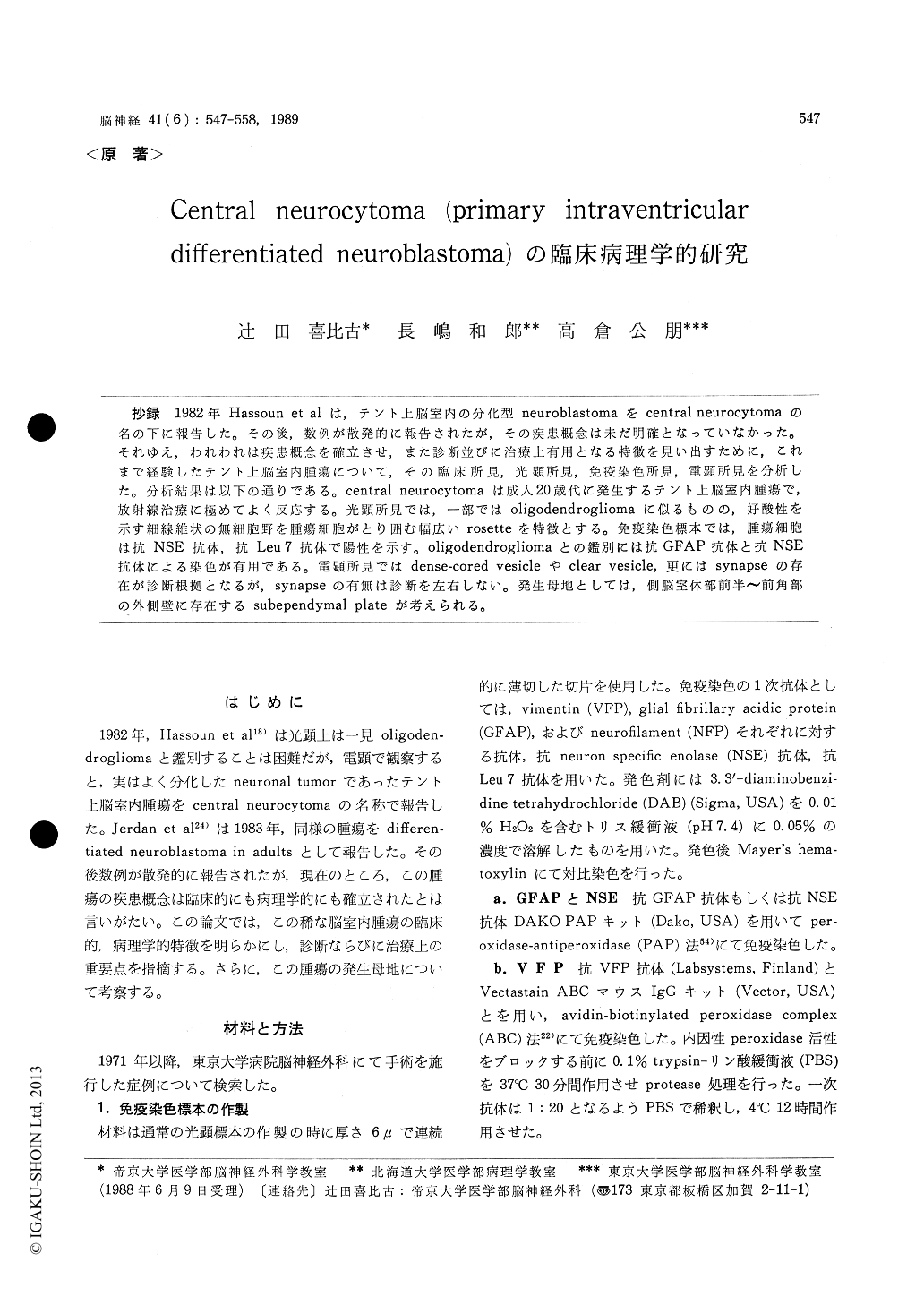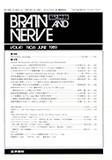Japanese
English
- 有料閲覧
- Abstract 文献概要
- 1ページ目 Look Inside
抄録 1982年Hassoun et alは,テント上脳室内の分化型neuroblastomaをcentral neurocytornaの名の下に報告した。その後,数例が散発的に報告されたが,その疾患概念は未だ明確となっていなかった。それゆえ,われわれは疾患概念を確立させ,また診断並びに治療上有用となる特徴を見い出すために,これまで経験したテント上脳室内腫瘍について,その臨床所見,光顕所見,免疫染色所見,電顕所見を分析した。分析結果は以下の通りである。central neurocytomaは成人20歳代に発生するテント上脳室内腫瘍で,放射線治療に極めてよく反応する。光顕所見では,一部ではoligodendrogliomaに似るものの,好酸性を示す細線維状の無細胞野を腫瘍細胞がとり囲む幅広いrosetteを特徴とする。免疫染色標本では,腫瘍細胞は抗NSE抗体,抗Leu 7抗体で陽性を示す。oligodendrogliomaとの鑑別には抗GFAP抗体と抗NSE抗体による染色が有用である。電顕所見ではdense-cored vesicleやclear vesicle,更にはsynapseの存在が診断根拠となるが,synapseの有無は診断を左右しない。発生母地としては,側脳室体部前半〜前角部の外側壁に存在するsubependymal plateが考えられる。
In 1982, Hassoun et al. reported two cases of differentiated neuroblastoma with the clinical and light microscopic appearance of intraventricular oligodendroglioma and gave a name of "central neurocytoma" to this tumor. Jerdan et al. (1983) called the similar tumor as "differentiated cerebral neuroblastoma in adults". As the tumor can be diagnosed only by ultrastractural study, the es-tablished cases so far reported are very rare. In this paper we present five cases identical to those presented by Hassoun et al. and clarify the essen-tial nature of this new category of brain tumors. All of our cases of central neurocytoma occurred in the lateral ventricles of young adults. Clini-cally there was no evidence of leptomeningeal or ventricular dissemination of tumor cells. After subtotal resection of the tumor and 6000 rads of whole brain irradiation, the tumor mass disap-peared and no evidence for recurrence of the tumor was noted on CT scan.
All cases showed almost the same histology. The tumor cells contained a small round and/or oval nucleus, and had eosinophilic thin delicate cyto-plasmic processes. There were no Homer Wright rosette, but were anuclear spaces consisting of fine fibrillar structures, like so called "broad rosettes" or "large rosettes". Capillary mesh was found among the tumor cells, but there was no endo-thelial proliferation. The tumor cells were mono-tonous, lacking pleomorphism, mitotic figures, and necrotic foci. Calcifications were observed in two cases. In the areas where the tumor cells arrangedloosely, cytoplasms became clear, showing peri-nuclear halo, like those of oligodendrogliomas.
Immunohistochemical examination showed GFAP and vimentin positive cells were all reactive astro-cytes around capillaries and near calcifications. No tumor cells contained GFAP and vimentin. The tumor cells were also negative for neurofila-ment both of 70 KD and 200 KD. NSE was more or less positive for tumor cell cytoplasm as well as fine fibrillaries. Anti-Leu7 antibodies stained only fine cytoplasmic processes, but not cytoplasm. Some reactive astrocytes were stained with anti-Leu7 antibodies.
Electron microscopic examination showed nuclei of the tumor cells were roughly round or oval without nuclear indentations and contained finely dispersed nucleochromain. In the cytoplasm, there were numerous free ribosomes, mitochondria, Golgi apparatus and electron dense various-shaped granules. Microtubules were found in the peri-phery of the cells, but filamentous structures were not identified. The areas apart from cell bodies and anuclear places, so called "broad rosettes", con-sisted of a collection of slender cytoplasmic pro-cesses and their terminals, reminiscent of neuropile of the normal brain. In the cytoplasmic processes and their terminals there were numerous clear vesicles like presynaptic boutons. Dense-cored vesicles were also encountered in some terminals. Synaptic structures with pre- and post-synaptic densities were occasionally found.
Central neurocytomas differ widely in the age of the patient, the region of the tumor development, and the grade of the histologic differentiation from cerebral hemispheric neuroblastomas. These wide differences may be due to the difference of the site from which each of the tumors originated. Cere-bral hemispheric neuroblastomas, which are found most often in childhood, are suspected to originate from the neuroblasts which arise from the multi-potential matrix cells in the ventricular zone of the primitive neural tube. On the other hand, central neurocytomas might originate from the neuroblasts in the subependymal plate of the lateral ventricle which is the remnant of the ventricular zone and a neoplastic hit might occur after birth.

Copyright © 1989, Igaku-Shoin Ltd. All rights reserved.


